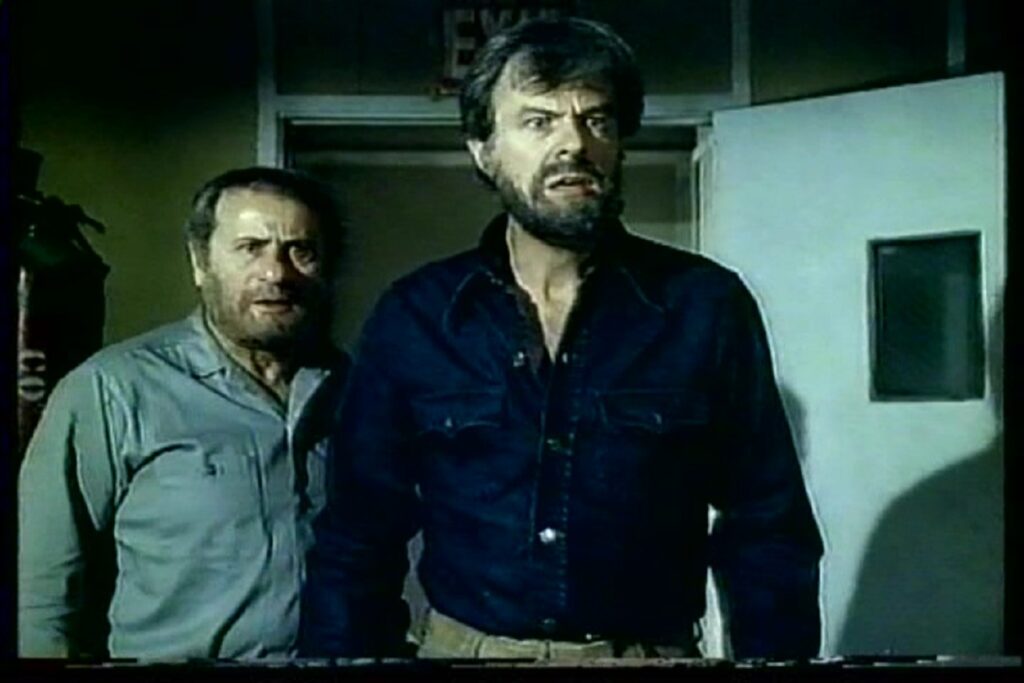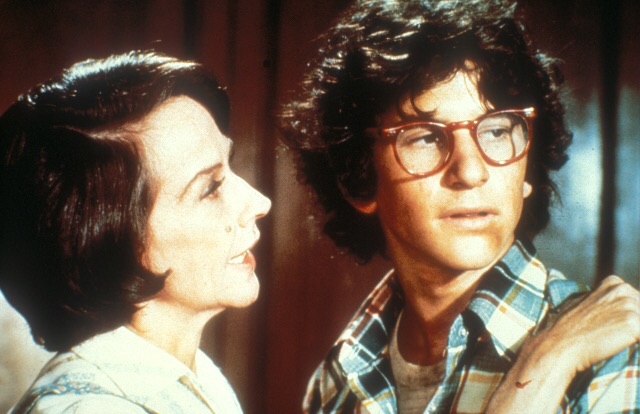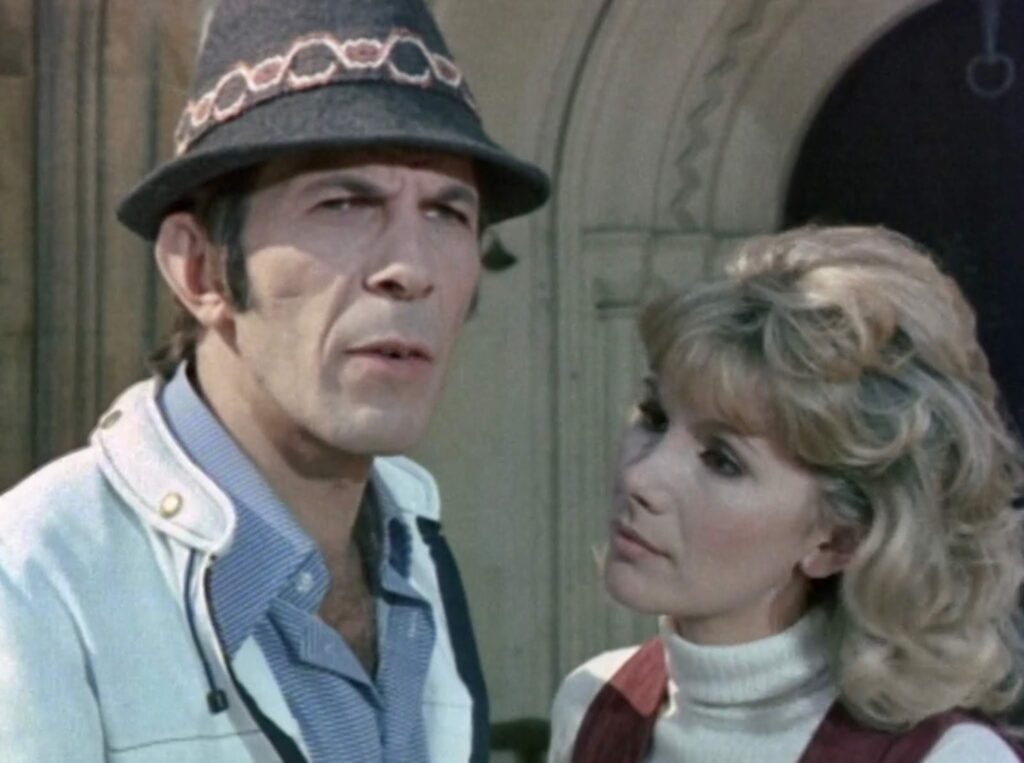There’s more than a little blurring of lines between movies and TV (including streaming) these days. But in the 1960s and 1970s, the division between what we watched on TV and what we paid to see in theaters was as solid as the Berlin wall.
Despite the division, network TV executives really, really wanted you to think that what you watched on TV was as good as theatrical movies, with big-name casts … or at least a couple of big names.
And plenty of thrills.
So the networks poured some money and effort and a boatload of marketing into made-for-TV movies, and in the 1970s, many of the best of them were mysteries and thrillers with a touch—or sometimes more than a touch—of horror and science fiction.
I mean, where else in the 1970s could you see Leonard Nimoy, a few years into his post-“Star Trek,” “I Am Not Spock” phase, starring as a race car driver with psychic powers?
Here’s a look at some of the greatest—and not as great, frankly—TV movies of the 1970s.
Not-ready-for-primetime thrillers
I should note right at the start that this article does not cover the “NBC Mystery Movie,” which produced the highs of “Columbo” and the lows of “McCoy,” a Tony Curtis vehicle “inspired” by big con movies like “The Sting.” The NBC anthology series no doubt rates its own CrimeReads article. And I should note that made-for-TV movies are a different animal than theatrical movies that were shown on TV.
Although the TV movie’s heyday came in the 1970s, its roots reach deeper, all the way back to prestige showcases for drama as early as the 1950s.
But the history of the TV movie is generally considered to have begun with “See How They Run,” from October 1964. The cast included John Forsythe and Leslie Nielsen, the latter in one of his many, many dramatic roles before he was cast in “Airplane” and the “Naked Gun” movies.
More interesting is the tidbit that “The Killers,” the 1964 Don Siegel movie, was reportedly intended to be a made-for-TV movie. A hard-edged crime drama, “The Killers” stars Lee Marvin and Clu Gulager as hitmen who kill a race car driver-turned-teacher for the blind played by actor and budding director John Cassavetes. After killing their quarry, they begin to put together the pieces of the puzzle about his life. The cast is amazing and includes Ronald Reagan as a tough guy.
That somebody ever thought Siegel’s movie was suitable primetime fare is amazing.
That kind of thinking was repeated with “Chamber of Horrors,” a 1966 horror film that was also apparently intended for TV. Even though it is more lighthearted than “The Killers,” “Chamber of Horrors” still seems like unlikely TV fare. With too-gruesome-for-TV killings preceded by cheesy on-screen warnings, the Fear Flasher and the Horror Horn. “Chamber of Horrors” does end, though, with a most TV-perfect scene in which Cesare Danova and Wilfred Hyde-White, the proprietors of a turn-of-the-century wax museum, chuckle in anticipation at the thought of their next mystery.
Made-for-TV movies continued to air as the networks tried to convince viewers to stay home, but the whole TV movie genre really took off in September 1969.

ABC set the standard for TV movies
In the late 1960s, the ABC broadcast network was a perennial third-place finisher in the ratings race, lagging behind CBS and NBC. ABC executives thought they had nothing to lose by experimenting, so they created “The ABC Movie of the Week.”
The series of movies was promoted as “an original motion picture produced especially for the Movie of the Week.” The use of the phrase “motion picture” seemed to imply class, of course.
The anthology film series began on September 23, 1969 with the airing of “Seven in Darkness,” about a plane crash whose seven survivors are all blind and must make their way out of the wilderness together. It starred old-school comedian Milton Berle, so perhaps there were bugs to be worked out of the prestige made-for-TV movie machine.
The first year’s worth of TV movies were dominated by thrillers starring the likes of Christopher George in the pilot for “The Immortal,” a TV series that I previously wrote about for CrimeReads, as well as films starring Eva Gabor, Sammy Davis Jr., Larry Hagman and Karen Valentine as the new Gidget. That movie, “Gidget Grows Up,” was a pilot for a TV series, a practice to be repeated many times during the 1970s TV-movie era.
The second season of the ABC movie anthology gave viewers more dynamic thrillers, though. “How Awful about Allan” starred Anthony Perkins. James Franciscus of “Longstreet” and Leslie Nielsen starred in “Night Slaves.” “The House That Would Not Die” featured Barbara Stanwyck.
To this day, I remember the second-season entry, “Tribes,” featuring Jan-Michael Vincent, future “Airwolf” star, being put through his paces by tough Marine drill sergeant Darren McGavin, soon to star in “The Night Stalker.”
Bing Crosby, whose production company made many TV movies, starred in “Dr. Cook’s Garden.” Der Bingle was up to no good in this thriller.
“Longstreet,” the James Franciscus crime drama about an insurance investigator blinded in an explosion, debuted as a TV movie in the second season.
The weekly ABC series continued like this through 1975: A mix of one-shots and TV pilots, some of which worked and some that did not, what must have been vanity projects for stars and fading stars plus the odd remake like “Death Takes a Holiday.”

The killer truck that made a director’s career
When “Duel” aired in November 1971 as part of the third season of “The ABC Movie of the Week,” the movie helped cement the small-screen stardom of Dennis Weaver, who was already playing cowboy detective “McCloud” as part of NBC’s mystery movie anthology. “Duel” really demonstrated director Steven Spielberg’s talent for creating a thriller out of nothing but a guy on a lonely stretch of road hunted by a behemoth truck with an unseen driver. “Duel” was Spielberg’s dry run for “Jaws,” which came out four years later and clinched Spielberg’s status as the most famous director since Alfred Hitchcock.
“Duel” was fueled by Richard Matheson’s story and screenplay, Weaver’s growing sense of terror as the story plays out and the sinister camera angles of the truck. If “Psycho” made us fear showers and “Jaws” drove us from the beach, “Duel” made us uneasy looking in our rearview to see a truck coming up behind us.
“Duel” let the mystery of its antagonistic truck driver go unsolved, thankfully. We really didn’t need scenes of the driver getting into an argument with his wife before going out on the road in a murderous rage. The movie didn’t need a neat explanation to become the model for mechanized mayhem thrillers to come, from “Killdozer” to “Maximum Overdrive” to “The Car.”
That same season, ABC’s movie anthology brought us “Brian’s Song,” which was not a mystery or thriller but inspired more manly tears than a dozen Super Bowls. It showed how powerful the TV medium could be in inspiring us.
Still to come in the third season of the ABC movie series was a thriller that changed how viewers thought about films for the small screen: a noir thriller about a newspaper reporter determined to expose a vampire.

The G.O.A.T. – ‘The Night Stalker’
On the night of January 11, 1972, ABC’s made-for-TV movie made history.
“The Night Stalker”—based on an unpublished book by Jeff Rice and adapted by “Duel” writer Matheson, director John Llewellyn Moxey and “Dark Shadows” producer Dan Curtis and starring Darren McGavin—was a thriller about a reporter pursuing the truth behind a series of Las Vegas slayings. Along with “Brian’s Song” and “Duel,” “The Night Stalker” helped legitimize the whole made-for-TV-movie genre.
I’ll admit “The Night Stalker” is my favorite of all of the ABC movies and I’d argue that the vampire-in-Vegas movie is more noir than horror: Carl Kolchak, a hard-bitten reporter, a three-time loser (at least) in love and newspaper jobs, investigates a series of slayings in Las Vegas. It has all the noir elements: a world-weary hero who supplies voice-over narration; shocking newspaper headlines accompanied by sketches of suspects; helpful doctors and coroners; police shootouts; duplicitous public officials and even veteran character actors Stanley Adams, Ralph Meeker, Claude Akins and Elisha Cook Jr. Barry Atwater was sparingly used, and made a huge impression, as the vampire.
Part of the appeal of “The Night Stalker” is included in Kolchak’s recounting of the murders: Readers could enjoy the outlandish story and then try to tell themselves that it couldn’t happen in their town.
“The Night Stalker” became the highest-rated made-for-TV movie of its time, with a 48 share, meaning that 48 percent of the TVs in use that evening were tuned in to McGavin and his quarry. The movie inspired a sequel, “The Night Strangler” and a single-season TV series with McGavin pursuing even more monsters.

Murderous primates, startling exclamation marks … and Satan finally gets in on the act
By the time of the final three seasons of “The ABC Movie of the Week,” the “motion picture produced especially” for TV was not limited to ABC, as the other networks hoped to get on the made-for-TV movie gravy train.
To be certain, ABC still dominated the arena.
In the fourth season of ABC’s movie series, one of its best psychological thrillers, “A Cold Night’s Death,” first aired. The setting might remind viewers of “The Thing,” either the original or John Carpenter’s later remake. In a frigid and remote Arctic research station, a lone scientist freezes to death indoors.
Two researchers, played by Robert Culp and Eli Wallach, arrive to investigate and continue research on the study’s subjects: chimpanzees.
“A Cold Night’s Death” had a lot to say about not only human psychology as filtered through the lens of isolation and paranoia but also about animal experimentation. The final shot is memorable.
It’s unimaginable that ABC’s TV movies didn’t feature a title like “Satan’s School for Girls” until its fifth season. The thriller debuted in September 1973 and the title alone is all you need to know about the story, other than it stars some of the best TV performers of the 1970s, including Kate Jackson, Cheryl Ladd, Pamela Franklin and Roy Thinnes, the latter of “The Norliss Tapes.”

Murderous nerds and murderous dolls
The fifth ABC season was big on dramatic punctuation. “She Lives!” and “Hijack!” and “Runaway!” aired within weeks of each other, followed a few weeks later by “Get Christie Love!” “Heatwave!” “Killdozer!” and “Cry Panic!”
One of the most famous, perhaps infamous, movies to air as part of the ABC series came in the sixth season, airing in October 1974.
“Bad Ronald” could be jokingly described as a movie about the original incel. Scott Jacoby plays Ronald, a high school student who lives in a fantasy world that centers on his art and his stories about a heroic prince (himself, of course) and a young princess. Ronald is subjected to teasing and ostracizing at school.
When Ronald accidentally kills a girl and disposes of her body, his mother (Kim Hunter) hides him in dusty crawlspaces and behind-the-wall access panels in their house. He goes on hiding there after his mother dies and the house is sold to Dabney Coleman and his wife and three school-age daughters.
Through peepholes he drills in the walls, Ronald spies on the new family, fixating on the youngest of the sisters, imagining her as the princess of his fantasies.
There’s probably a reason “Bad Ronald” is so memorable. There’s a sleazy aura not only to Ronald but the movie itself, which features shots that linger a little too long on the daughters.
Ronald is filthy from living behind the walls so when he comes out and confronts the youngest daughter, calling her his princess, he clamps his dirty hand over her mouth, leaving greasy, dirty smears on her face. Girl, I want you to escape as much as anybody, but can you stop and wash your face first?
For all my clowning of “Bad Ronald,” there is a genuinely artful moment when one of the girls notices a shaft of light coming from one of the peepholes. She slowly draws closer to it, a fearful expression on her face. The light shining on her face grows brighter until, suddenly, Ronald’s eye appears through the peephole. Cue the screaming.
An equally famous—but genuinely well-crafted—entry in the ABC movies came in March 1975, the final season of the series. “Trilogy of Terror” was an anthology within an anthology, adapting stories by Richard Matheson, best known for “I Am Legend” and his TV movie work. The first two stories were perfectly serviceable thrillers but the third, “Amelia,” featured Karen Black alone in her apartment with a murderous tribal doll. It was another landmark in TV movies.
“The ABC Movie of the Week” wound down in the spring of 1975 with pilots for “Starsky & Hutch” and a revival of the “Matt Helm” series, this time featuring Tony Franciosa rather than Dean Martin.
But not all effective and memorable 1970s TV movies were part of ABC’s “Movie of the Week” series.

Things start to get spooky
Leonard Nimoy had been away from “Star Trek” for a few years and was still trying to find a career separate from Mr. Spock when he made “Baffled!” a British production that aired on NBC in 1973.
Like many of the ABC movies, the idea was that “Baffled!”—don’t forget that exclamation mark!—would spawn a regular weekly TV series. Nimoy plays a race car driver who has visions of an English manor house and a frightened woman before crashing his car.
When he talks about the visions, he’s sought out by Susan Hampshire as a book dealer and dabbler in extrasensory matters, who has become convinced that the driver has gained abilities that will help him fight the forces of evil.
Nimoy tries to help the new mistress of the aforementioned manor house, played by Vera Miles, with odd occurrences including the accelerated aging of her daughter, who goes from a stuffed animal to miniskirt and go-go boots overnight.
Nimoy is jocular and smiling as if to disassociate himself from the somber character that made his career. When he’s not grinning and joking he does knit his brows, in proper Spock style, and he tools around in an antique car.
It’s hard to find fault with any movie that has Nimoy say, “Any time you need a guy to wrestle with an old lady…”
Another NBC outing, “The Norliss Tapes,” seems so much like a remake of “The Night Stalker” that it probably should have aired as part of ABC’s movie series. Roy Thinnes stars in the 1973 thriller as David Norliss, a writer who usually debunks the supernatural. But Norliss stumbles across a mystery involving a woman (Angie Dickinson) who shot her husband … a few days after he was dead and buried in the family crypt.
“The Norliss Tapes” seems so reminiscent of “The Night Stalker” because of the main character, investigating a malevolent supernatural force, and his voiceover narration, but also because “Night Stalker” producer Dan Curtis and composer Robert Cobert were imported from the landmark ABC film, as were Claude Akins—here playing another hostile sheriff character—and Stanley Adams.
“The Norliss Tapes” has in common with “The Night Stalker” and big-screen movies like “Jaws” the subplot of public officials who want to cover up a series of horrific crimes.
“That’s all I need, a bunch of newspapermen crawling up my back,” Akins’ sheriff says. “I can see the headlines now, ‘Vampire killer loose in Monterey.’”
This plot point maybe wasn’t surprising in the Nixon era.
In the decade following “Star Trek,” series creator Gene Roddenberry made several TV movie pilots for new series. None of them struck pay dirt like “Star Trek,” but arguably the best of them was “Spectre,” another Brit-made production that aired on NBC, this one in 1977.
“Spectre” featured Robert Culp and Gig Young as friends William Sebastian and Dr. “Ham” Hamilton, the story’s Holmes and Watson, or Kirk and Dr. McCoy surrogates. Culp’s character is a criminologist who has begun finding evidence of the supernatural in crimes, while Young is an alcoholic physician with an unfortunate habit of being way too interested in young nurses.
The presence of Majel Barrett—Roddenberry’s wife and “Star Trek” player—as Sebastian’s witchcraft-savvy assistant—and Roddenberry’s attitudes about sex really make this a movie of its time. Not to mention the soundtrack, which veers from harpsichord to guitar filtered through a wah-wah pedal.
But there’s quite a lot to like about “Spectre,” including a teenage-looking John Hurt as the younger brother of a troubled family. It would only be a couple of years before Hurt starred in “Alien,” but he looks shockingly younger here.
And there’s some genuinely spooky moments and enjoyable lines, as when a startled Hamilton asks, “What the devil?” and Culp replies, “Yes. Exactly.”
At another point, Culp pulls out a crucifix to defend himself from evil and Hamilton pulls out a Star of David.
Many of the most memorable TV movies of the 1970s feel dated and very much of their period. But they’re good mystery-thrillers. And where else can you find a good harpsichord soundtrack?

















